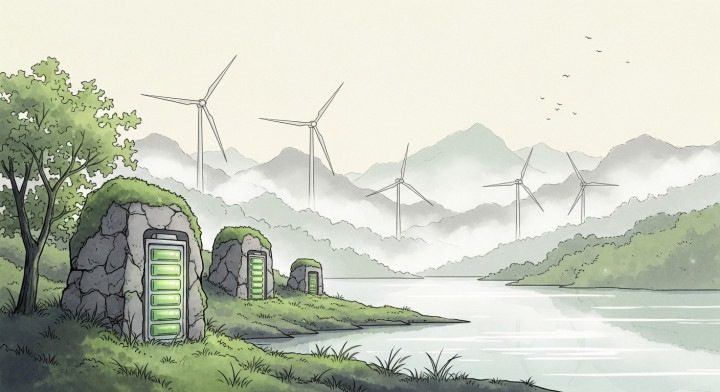This apparent contradiction highlights a critical gap: it is not enough to generate energy; we must be able to use it when and where we need it. This is where energy storage comes into play, serving not just as a technical aid, but as a cornerstone of the clean energy transition, energy independence, and global climate action.
Why Storage is Inevitable
Renewable energy sources, particularly wind and solar, are often met with skepticism. These debates touch upon the entire lifecycle of the technologies: the environmental impact of manufacturing and installing wind turbines, the difficulty of recycling their blades, and the associated costs. While these aspects are fundamentally important in a comprehensive energy strategy, this analysis deliberately focuses on another, inseparable yet more specific challenge. This challenge is the inherent intermittency, or volatility, of renewables, which fundamentally questions the stability of the energy system, regardless of how sustainable the generation technology itself is considered.
The greatest advantage of traditional, fossil fuel-based power plants (coal, gas) was their dispatchability. They generated energy when consumption demanded it, making it relatively easy to maintain the delicate balance between supply and demand. In contrast, renewable sources are weather-dependent and intermittent. The sun only shines during the day, and the wind does not blow with constant force.
This volatility causes serious problems for the electrical grid:
-
Overproduction: On a sunny, windy afternoon, renewable power plants can generate more energy than the grid can immediately absorb. In such cases, production must be artificially curtailed, which essentially means wasting clean energy.
-
Shortage: In the evening, when solar panels are no longer generating but peak consumption (lighting, heating, cooking) begins, a sudden energy deficit occurs. Today, this gap is often filled by expensive and polluting gas-fired "peaker" plants that can be started up quickly.
Energy storage bridges this dual problem. It acts as an energy buffer: it "charges" during times of overproduction and then discharges the stored energy during periods of deficit. By doing so, it smooths out production curves, stabilizes the grid, reduces dependence on fossil fuels, and allows for the maximum utilization of renewable resources. This issue is not merely technical but also deeply geopolitical: a country that can effectively store its own clean energy significantly reduces its exposure to the fluctuations of international gas and oil markets.
The Diverse World of Energy Storage Technologies
The most practical way to categorize energy storage systems is by the form in which they store energy.
1. Mechanical Storage:
-
Pumped-Hydro Storage (PHS): The most widespread and mature large-scale technology. It uses excess electricity to pump water to a higher-elevation reservoir. When energy is needed, the water is released, flowing through turbines to generate electricity. It offers massive capacity but has significant geographical and environmental constraints.
-
Compressed Air Energy Storage (CAES): Excess electricity is used to compress air at high pressure into underground caverns (e.g., salt mines, depleted gas fields). To recover the energy, the compressed air is released to drive a turbine. Its drawbacks include reliance on geological formations and heat loss.
-
Flywheel Storage: A massive wheel is spun to high speeds, storing energy in kinetic form. It has a rapid response time but can only provide power for short durations (minutes), making it primarily suitable for grid frequency stabilization.
2. Electrochemical Storage (Batteries):
-
Lithium-ion (Li-ion) Batteries: Currently the most dynamically developing segment. Characterized by high energy density, decreasing costs, and versatile applications (from electric vehicles to grid-scale storage). However, it faces serious challenges: the mining of lithium, cobalt, and nickel raises environmental and ethical concerns, supply chains are geopolitically vulnerable, and issues of fire risk and recycling still need to be resolved.
-
Flow Batteries: Particularly promising for long-duration, grid-scale storage. Energy is stored in liquid electrolytes held in external tanks. Their advantage is that power (reactor size) and capacity (tank size) can be scaled independently, they have a very long lifespan, and are not a fire hazard.
-
Emerging Technologies: Sodium-ion, zinc-ion, and solid-state batteries are emerging as alternatives to lithium-ion, aiming to replace critical raw materials and improve safety.
3. Chemical Storage:
-
Hydrogen (Power-to-Gas): The "holy grail" of long-term, seasonal energy storage. In this process, excess (green) electricity is used to produce hydrogen through water electrolysis. The hydrogen can be stored, transported, and then converted back into electricity in a fuel cell or gas turbine. Despite its huge potential, its round-trip efficiency is still relatively low, and storing and transporting hydrogen requires significant infrastructure development.
4. Thermal Storage:
-
Energy is stored as heat in a medium (e.g., molten salt, sand, rocks). It is particularly effective in Concentrated Solar Power (CSP) plants, where molten salt heated by the sun can generate steam and drive turbines even at night.
Promising Prototypes and the Direction of the Future
Research and development are progressing rapidly, with many innovative solutions on the horizon:
-
Gravity Storage: This concept follows the logic of pumped-hydro but uses solid masses (e.g., concrete blocks) instead of water. A company called Energy Vault uses cranes to lift and stack massive blocks, then generates electricity by lowering them. Its advantage is that it is not dependent on geography.
-
Sand Battery: A development by Finnish startup Polar Night Energy, which heats sand up to 500-600°C in a large, insulated steel tank using surplus electricity. It can retain the stored heat for months and is used to supply district heating systems. It is an extremely cheap and environmentally friendly solution.
-
Liquid Air Energy Storage (LAES): Air is cooled to -196°C, turning it into a liquid that is stored in an insulated tank. To recover the energy, the liquid air is warmed, causing it to rapidly expand and drive a turbine. It has potential for large-scale, long-duration storage.
The Obstacles
The path to widespread adoption of energy storage is paved not only with technological hurdles but also with economic, political, and social barriers.
-
Economic: Upfront investment costs (CAPEX) are still high. The return on investment is complicated by the fact that markets often do not recognize or compensate for all the services that energy storage provides (e.g., grid stability, frequency regulation). Government subsidies, regulatory incentives, and new business models are needed.
-
Raw Material and Geopolitical Dependence: As mentioned, lithium-ion technology depends on critical minerals whose mining and processing are concentrated in a few countries. This creates supply chain risks and geopolitical tensions.
-
Regulatory Environment: Legislation and permitting processes are often slow and fail to keep pace with technological advancements. An energy storage unit is simultaneously a producer and a consumer, a concept that is difficult to interpret within traditional regulatory frameworks.
-
Environmental Footprint and Lifecycle: The solutions must be truly sustainable. The environmental impacts of manufacturing (mining, transportation) and end-of-life management (recycling) must be considered. A "green" solution cannot be credible if its production or decommissioning is highly polluting.
The Era of Systems-Level Thinking
The future of energy storage will not be the triumph of a single technology. It lies in a diversified portfolio where different technologies complement each other to perform various tasks: flywheels for second-long fluctuations, lithium-ion batteries for daily cycles, and flow batteries and hydrogen for weekly or even seasonal storage.
Fundamentally, the real challenge is not just whether we can store energy, but how we do it. The goal is to build a system that is not only technically efficient but also economically viable, socially equitable, geopolitically secure, and environmentally sustainable. The energy storage revolution has already begun, and its success depends on our ability to pair technological innovation with wise regulation, forward-thinking economic policy, and global cooperation. This invisible engine will power the clean, stable, and democratic energy system of the 21st century.






